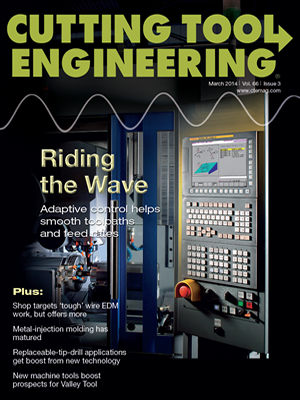Rolling-element spindle bearings require lubrication because even the best bearings experience significant sliding contact. The bearings and races are not perfect and deform under preload. As a result, the contacts between the rolling elements and the races are not points, but patches, and some parts of the patches slide. Lubrication reduces the heat generated during sliding and extends bearing life.
When spindle speed is low, such as a few thousand rpm for spindles a few inches in diameter, grease lubrication is sufficient. These bearings can be permanently sealed, or the grease can be replenished as it leaks out. Grease lubricant is quite viscous and will stay in place no matter the spindle orientation. In addition, such spindles usually are belt- or gear-driven, and the motor’s heat source is separated from the spindle.
As spindle speed increases, belts and gears become impractical, and the spindle design is modified so the spindle is the rotor of the motor. The heat generated by the motor escapes only through the bearings, and the bearings are not good conductors of heat. In addition, preload is increased to maintain spindle stiffness, and the bearings themselves become significant heat sources. The resulting temperature in the spindle becomes too high, typically at around 150° C (302° F), for grease lubrication. At this temperature, the grease can liquefy or burn, and oil lubrication is typically used instead.
Oil can be pumped through the bearings, but the sealing strategy becomes important, especially if the spindle is suitable for vertical and horizontal orientations. A liquid flow must not leak out, so a sealing strategy is required. It is easier to seal liquid in a horizontal spindle, because the fluid collects in an area where there is no gap. If the spindle is vertical, the gap between the spindle and housing is difficult to seal. Some spindles change orientation, which changes the oil flow, so sealing is a challenge.
The flowing oil helps remove heat from the spindle and bearings to a certain extent. At low flow rates, the oil provides some cooling, but its capacity to absorb heat is limited. As the flow of oil through the spindle increases, oil’s capacity to absorb heat increases, but the churning of the oil by the bearings eventually begins to generate heat on its own. The lubrication system must dissipate the heat generated by the spindle and by the churning oil. Spindle designers deal with the lubrication and heat problems in three common ways: chilled oil, oil mist and air/oil injection.
With chilled oil, the large flow of oil through the spindle is maintained, but the oil is chilled in a special refrigerator that sits beside the machine tool. The chiller consumes significant amounts of power, approaching or surpassing the power consumed during machining. The chilled oil may be pumped through the spindle, removing heat from the motor, then out through the bearings, where it is collected and returned to the refrigerator. The chilled oil in this system is contained, and contaminants are filtered from the oil. This solution is robust, but expensive.
In the oil-mist solution, a small amount of oil is introduced through a very small orifice into a flow of air so the oil becomes atomized in the air as a mist. The concentration of the oil in the air is low, and as the mist passes into the bearing, the oil is distributed throughout the moving elements. The oil is usually not collected, because much of it exits the spindle still as a mist. Outside the spindle, care must be taken to confine the mist and remove the oil because the mist is a health and safety hazard to operators. It can also collect on the workpiece and in the workspace and contaminate the coolant as tramp oil. Positive air pressure helps keep contaminants out of the spindle bearings.
The air/oil method requires a few drops of oil to be injected using a device similar to a syringe into a tube with flowing air. The air draws the oil along the sides of a tube, but does not atomize it. Typically, there are several tubes per bearing. If the tubes are transparent, it is possible to see the oil flowing along the tube walls in streaks. Because the oil is not atomized in the air, the oil can be collected as it leaves the bearing using a labyrinth seal. It provides lubrication, and the airflow significantly cools the bearings.
With a chilled-oil system, spindles can be designed with fixed-bearing positions, and the chilled oil maintains a constant temperature and bearing preload. In both the oil-mist and the air/oil systems, the spindle operating temperature varies with speed and is generally higher. Spindle designers using these systems must incorporate moving elements to keep the bearing preload—and the resulting stiffness—in the desired range. CTE
About the Author: Dr. Scott Smith is a professor and chair of the Department of Mechanical Engineering at the William States Lee College of Engineering, University of North Carolina at Charlotte, specializing in machine tool structural dynamics. Contact him via e-mail at [email protected].
Related Glossary Terms
- coolant
coolant
Fluid that reduces temperature buildup at the tool/workpiece interface during machining. Normally takes the form of a liquid such as soluble or chemical mixtures (semisynthetic, synthetic) but can be pressurized air or other gas. Because of water’s ability to absorb great quantities of heat, it is widely used as a coolant and vehicle for various cutting compounds, with the water-to-compound ratio varying with the machining task. See cutting fluid; semisynthetic cutting fluid; soluble-oil cutting fluid; synthetic cutting fluid.
- stiffness
stiffness
1. Ability of a material or part to resist elastic deflection. 2. The rate of stress with respect to strain; the greater the stress required to produce a given strain, the stiffer the material is said to be. See dynamic stiffness; static stiffness.
- tramp oil
tramp oil
Oil that is present in a metalworking fluid mix that is not from the product concentrate. The usual sources are machine tool lubrication system leaks.


